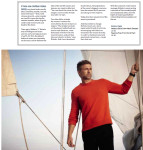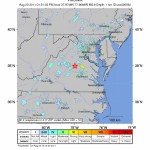
With but hours (Pacific time) from Black Friday, the most epic endurance retail binge known to primates, I thought I’d pause to reflect on a confluence of science, conservation, and consumerism that has me scratching my head.
The above ad is courtesy of men’s outerwear retailer Nautica, and features noted sea turtle scientist, conservationist, and fellow Californian Wallace “J” Nichols. In the four-page advertisement now running in GQ’s November issue, J makes all us marine biologists less genetically gifted with cheekbones, great hair, and piercing blue eyes whither in comparison.
But you don’t have to take my word for it. To wit:
If you suspect I’m about to launch into a diatribe about what appears to be the latest example in the re-framing of “scientists as cool” bandwagon, you’re wrong. Well, maybe you’re half wrong. This ad sure seems to be barking up that tree. But Kevin has already raised all the necessary concerns that I would have mentioned already.
And besides, it might just sound like sour grapes. I mean, all due respect J! You are a stunning man with a great mind and you deserve to be a poster boy for ocean conservation to the general public. Besides, GQ readers may not be ready for Jeremy Jackson’s ponytail.
But what does bug me about the ad is the commodification that seems to be running in opposition to the conservation message.
The Nautica ad is promoting a brand of clothing that is allegedly supposed to also mirror a brand of activism. The underlying message: If you care as much as J, you’ll also want to look like J.
In the copy accompanying the ad, J points out how despite the appearance that our oceans are vast and invulnerable, we are indeed leaving our mark, “The wildest animals on the planet, leatherback sea turtles and albatross, roam thousands of miles from the nearest human, and yet they have our plastic in them.”
But here’s the thing. Most of that plastic that J alludes to comes from land based sources. Land-based discharges of plastic debris (mostly bags, packaging, single-use disposable products, and tiny resin pellets used in the manufacturing of larger plastic materials) comprise the largest source of marine debris in oceans world-wide (nearly 80%). I’m admittedly getting into Miriam’s territory here, so I’ll just refer you to her work on SEAPLEX for more of the science behind marine plastic debris.
So much of this plastic production is driven by a consumer culture being endlessly assaulted with signals of what they need. The creation and fostering of a desire to purchase goods or services in even greater amount and diversity. Whether it’s bottles of boutique “spring” water or Nautica clothing, demand drives resource extraction, production, packaging, distribution, all the way down to the consumer who acquires, uses, and discards. Go watch The Story of Stuff for the better telling of the consumer cycle and associated resource costs.
My point is whether J’s message is best being served while piggy-backed atop a line of pricey “stuff” that we are apparently being told we “need”. Perhaps I’m over analyzing this in my own foggy, post-Thanksgiving consumer (literally) haze. I’m not saying J should be standing on a beach in some organic cotton tie-died shirt to pitch his message. But I guess I like my biodiversity conservation icons more aligned to The Lorax rather than a Madison Avenue-produced catalog.









Thanks for this post, Rick. It’s a healthy conversation to have.
I understand some of your complaints, but I think what we’re seeing here is positive change. In the interest of balance, it seems fair to mention the upside to ocean conservation from this GQ ad.
First, the ad brings wider distribution of the ocean conservation message. Next, the ad uses a model that represents positive change rather than a model that represents nothing in particular. Next again, the ad represents a form of commitment from Nautica. The ocean needs all the help it can get, and Nautica’s clothing line is ocean themed, so corporate support for ocean conservation would seem appropriate.
Thanks again for your thoughtful post. Happy Thanksgiving, all!
Good discussion. Let’s keep experimenting with ways to take our urgent message beyond the choir.
Remember Dorismar who helped us save sea turtles? The pro sports figures?
PS The Lorax is my favorite book, we read it to the kids often. And I’ll use this space to suggest that if you want a cool, organic holiday gift that supports small farms and artisans, check out our blog SLOWCOAST.org ; )
BTW, Rick, I think your genetic gifts are formidable ; ) no need to wither…
I would like to add something to Rick’s insight, ( which I think is great!), maybe to wrap this campaign NAUTICA could ( should), implement a environmentally conscience in their own production line, distribution and final sale, e.g. don’t give the nice jacket to the costumer in a plastic bag!, deliver products in recyclable paper bags, and continue with the chain that will lead campaigns like this to have serious impact in the oceans, to really make a difference, by starting at home…I do appreciate the fact the Dr. J, appears in this campaign and that already talks about their commitment to help spread the word..I want one of those black coats…
Related Metafilter discussion: Stoichiometry is a harsh taskmistress
Thanks for the comments, Peter. I certainly will take ANY airtime to the masses oceans can get. And I agree that J is the perfect model who walks the walk and talks the talk. I do indeed hope Nautica is driving customers to either contribute financially to conservation efforts or get more involved personally.
Heh. Thanks, J. You’re generous.
And agreed, now is the time for experimental and pragmatic approaches to getting our message to resonate.
Glad to hear you’re also keeping The Lorax alive for the next generation!
Thanks, Ariel. Great ideas! An opt-out option at point of sale would be something proactive Nautica could do. Not sure whether a percent of sales also supports ocean conservation.
And yes, I want a black coat too.